View in other NatureServe Network Field Guides
NatureServe
Montana
Utah
Wyoming
Idaho
Wisconsin
British Columbia
South Carolina
Yukon
California
New York
Meesia Moss - Meesia triquetra
General Description
Plant: Acrocarpous (Vitt 1988), scattered or tufted. Dark green to yellow-green, often blackish below. Stems 2-14 cm tall, simple, but occasionally a little branched. Rhizoids papillose.
Leaf: When dry, leaves somewhat contorted. When moist, leaves squarrose. Leaves 2-3.6 mm long, triangular-lanceolate, and with a sheathing base. Margins plane or sometimes recurved at mid-leaf and serrate for most of its length. Costa ends before the apex or is almost percurrent and is narrow (less than 1/5 width of leaf at base).
Leaf Cells: Upper and median leaf cells about 15 µm wide, rectangular to hexagonal. Basal laminal cells elongate and somewhat hyaline. The costa in X-S has small, thick-walls except for the ventral and dorsal layers. Leaf cells are very large and easy to see with a hand lens.
Diagnostic Characteristics
Three-ranked and widely spreading leaves with serrulate margins frequently distinguish this moss. The similar M. longiseta is synoicous and has smooth leaf margins (FNA 2014).
Species Range
Montana Range
Range Descriptions

 Native
Native
Range Comments
Greenland; Canada: AB, BC, MB, NL, NT, NU, ON, QC, YT; USA: AK, CA, MI, MN, MT, NE, NJ, NY, OR, SD, VT; n Eurasia (FNA 2014). In Montana: Carbon, Flathead, Glacier, Lincoln, Ravalli, Sanders, and Teton Counties (Elliott 2016).
Observations in Montana Natural Heritage Program Database
Number of Observations: 27
(Click on the following maps and charts to see full sized version)
Map Help and Descriptions
Relative Density
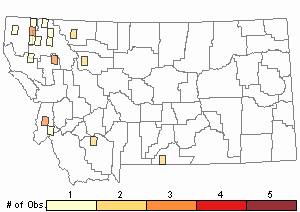
Recency
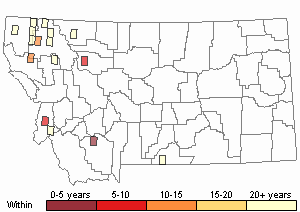
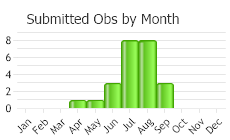
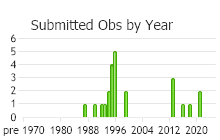
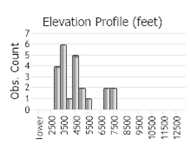 (Observations spanning multiple months or years are excluded from time charts)
(Observations spanning multiple months or years are excluded from time charts)
Habitat
Wet soil and peat in fens and bogs (Elliott 2016), soil in wet woods.
Reproductive Characteristics
Dioicous. Male plants have perigonia in terminal discoid heads. Seta is 4-10 cm long. Capsules are 2.8-5.5 mm long (with neck).
Stewardship Responsibility
References
- Literature Cited AboveLegend:
 View Online Publication
View Online Publication Elliott, J.C. and A.K. Pipp. 2018. A Checklist of Montana Mosses (1880-2018). Updated 3 January, 2020. Montana Natural Heritage Program, Helena, Montana. 73 pp.
Elliott, J.C. and A.K. Pipp. 2018. A Checklist of Montana Mosses (1880-2018). Updated 3 January, 2020. Montana Natural Heritage Program, Helena, Montana. 73 pp. Flora of North America Editorial Committee, eds. 2014. Flora of North America North of Mexico. Volume 28. Bryophytes: Mosses, Part 2. Oxford University Press, Inc., NY. xxi + 702 pp.
Flora of North America Editorial Committee, eds. 2014. Flora of North America North of Mexico. Volume 28. Bryophytes: Mosses, Part 2. Oxford University Press, Inc., NY. xxi + 702 pp. Vitt, D. J. Marsh, and R. Bovey. 1988. Mosses, Lichens & Ferns of Northwest North America. Seattle, WA: University of Washington Press. 296 p.
Vitt, D. J. Marsh, and R. Bovey. 1988. Mosses, Lichens & Ferns of Northwest North America. Seattle, WA: University of Washington Press. 296 p.
- Additional ReferencesLegend:
 View Online Publication
View Online Publication
Do you know of a citation we're missing? Elliot, J. C. 1993. Second checklist of Montana mosses. Unpublished report. U.S. Forest Service, Region 1. Missoula, MT. 45 pp.
Elliot, J. C. 1993. Second checklist of Montana mosses. Unpublished report. U.S. Forest Service, Region 1. Missoula, MT. 45 pp. Lawton, E. 1971. Keys for the Identification of the Mosses on the Pacific Northwest. Reprinted from 'Moss Flora of the Pacific Northwest'. Published as Supplement No. 2 of the Journal of the Hattori Botanical Laboratory. Nichinan, Miyazaki, Japan. 66 pp.
Lawton, E. 1971. Keys for the Identification of the Mosses on the Pacific Northwest. Reprinted from 'Moss Flora of the Pacific Northwest'. Published as Supplement No. 2 of the Journal of the Hattori Botanical Laboratory. Nichinan, Miyazaki, Japan. 66 pp. Lawton, E. 1971. Moss Flora of the Pacific Northwest. Hattori Botanical Laboratory. Japan: Yamabuki-cho, Shinjuku-ku, Tokyo. 362 pages plus appendices.
Lawton, E. 1971. Moss Flora of the Pacific Northwest. Hattori Botanical Laboratory. Japan: Yamabuki-cho, Shinjuku-ku, Tokyo. 362 pages plus appendices.
- Web Search Engines for Articles on "Meesia Moss"





